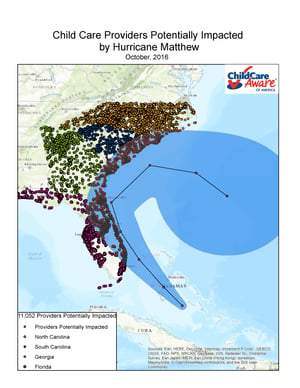Where are child care programs located? How many children attend child care programs? Where can I find child care after 8 p.m.?
Answering these questions is important as parents attempt to navigate the when, where, how and who of securing quality, affordable child care. Additionally, these questions become important after a disaster, particularly as communities attempt to pick up the pieces and rebuild.
Child Care Aware® of America's Emergency Preparedness Team is excited to tell you about the benefits of our unique Geographic Information Systems (GIS) maps. Through a myriad of data sources, including our National Data System (NDS) for Child Care, we are able to create rich, detailed maps with information down to the street level.
What kind of data are we talking about?
These maps help:
- Visualize the different offerings of child care in a community, such as child care centers and family child care homes
- Identify the licensed capacity and enrollment for each provider
- Highlight child care providers that are open during "non-traditional hours", such as before 7 a.m. or after 7 p.m.
- Overlay historical data to identify providers located in regions at higher risk for natural disasters
What is this Important?
By harnessing GIS technology to bring together disparate data sources, we provide first responders, emergency management officials and Child Care Resource and Referral (CCR&Rs) agencies with valuable information to aid in their decision making. Emergency managers, for example, can use these maps to better prepare their communities because it can show where children are located in the event of an emergency.
To view our maps and see first-hand how they can aid your community, click here.







